Science Highlights, December 23, 2015
Awards and Recognition

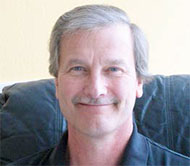


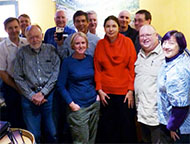
- Carlos Tomé wins Cyril Stanley Smith Award for materials research
- James Boncella named Bartlett Lecturer at the University of California - Berkeley
- Nuclear Testing Limitations Team receives accolades
- John Gordon selected to serve on journal’s International Advisory Board
- Los Alamos Northern New Mexico IEEE Section wins two excellence awards
Materials Physics and Applications
Experiments reveal possibility of polaronic Bose-Einstein condensates in UO2(+x)
Mesoscale Materials Science on the Roadmap to MaRIE
Key development for implementing the next generation of high brightness x-ray sources
Awards and Recognition
Carlos Tomé wins Cyril Stanley Smith Award for materials research
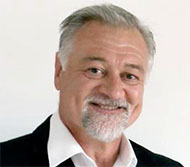
Carlos Tomé
Carlos Tomé (Materials Science in Radiation and Dynamics Extremes, MST-8) will receive the 2016 Cyril Stanley Smith Award for “outstanding contributions to the science of materials structure” at the annual meeting of The Minerals, Metals & Materials Society (TMS) in February.
Tomé earned a PhD in physics from the National University of La Plata, Argentina and joined the Lab in 1996. He has pioneered theories, models, and numerical codes that are used by hundreds of materials scientists and engineers in academia, national laboratories, and industry. Tomé focuses on the mechanical behavior of polycrystals, especially the role played by texture, twinning, and microstructure on the anisotropic properties of hexagonal metals and geologic materials. These approaches have led to revolutionary changes in how simulations and interpretation of measurements on mechanical behavior are conducted. He has published more than 170 papers in international journals and has co-authored the books Texture and Anisotropy and Fundamentals and Engineering of Severe Plastic Deformation. A 2011 TMS symposium, the 2013 Distinguished Scientist/Engineer Award presented by the TMS Structural Materials Division, and the 2016 Khan International Medal of Plasticity recognized his contributions to the mechanical behavior discipline. The DOE, Office of Basic Energy Sciences has funded his research for the past 12 years. The award is named after Cyril Smith, who was in charge of metallurgy at the Los Alamos site during the Manhattan Project, won the U.S. Presidential Medal for Merit in 1946, and held prominent positions in his field. Technical contact: Carlos Tomé
James Boncella named Bartlett Lecturer at the University of California - Berkeley

James Boncella
The University of California – Berkeley has selected James Boncella (Deputy Group Leader of Isotope, Inorganic, and Actinide Chemistry, C-IIAC) to be the Neil Bartlett Memorial Lecturer in the Department of Chemistry for the 2015-16 school year. The faculty bestowed this honor. He gave a lecture titled “What Can 5f Metal-Ligand Interactions Teach Us About Bonding?” as part of the inorganic chemistry seminar series.
Boncella received a PhD from the University of California – Berkeley, where he investigated divalent ytterbium compounds. He joined the Laboratory in 2003, working on the fundamental chemistry of uranium and other actinide species as well as a variety of other projects spanning from fuel cells to catalysts to surfactants and more.
The Bartlett family and the Dow Chemical Company endowed the Bartlett Memorial Lectureship. While a professor at the University of California – Berkeley, Neil Bartlett discovered that the noble gas element xenon could form compounds with other elements. He is considered “the father of xenon chemistry” for this achievement. Technical contact: James Boncella
Nuclear Testing Limitations Team receives accolades

Photo: (Left to right): Rick Kelley, Ward Hawkins, Lt. Gen. Frank Klotz, Aviva Sussman, and Liz Miller during the awards ceremony.
The Lab’s Nuclear Testing Limitation Team received recognition for providing scientific support to the Preparatory Commission of the Comprehensive Test-Ban Treaty (CTBT) Organization. In anticipation of the day when the CTBT goes into force, the Preparatory Commission is building a regime for treaty verification that includes onsite inspections of any country suspected of a violation. The Preparatory Commission’s Integrated Field Exercise 2014 (IFE14) tested all phases of an onsite inspection. The exercise involved 250 specialists from 46 countries. The event took place at two locations: Jordan’s Dead Sea and Austria, where the Commission is based.
The Los Alamos team played a critical role in the planning for IFE14 and in the execution of all related events. The team led development of a credible exercise scenario, helped all participants pursue their IFE14 roles, and ensured the integrity and plausibility of the scenario throughout the duration of the event. The exercise garnered significant national and international attention. The U.S. Under Secretary for Arms Control and International Security, Rose Gottemoeller; NNSA Deputy Administrator for Defense Nuclear Nonproliferation, Anne Harrington; and other global dignitaries visited the exercise. The team’s participation contributed to international nuclear nonproliferation efforts, and it resulted in a significant programmatic achievement.
In a Laboratory ceremony, Under Secretary for Nuclear Security and Administrator for the NNSA Lt. Gen. (retired) Frank Klotz presented awards to Geophysics (EES-17) and Earth System Observations (EES-14) employees for their work during the 2014 Integrated Field Exercise. Ward Hawkins (EES-17) received the NNSA Silver Award for Distinguished Service. Aviva Sussman and Ken Wohletz (EES-17) as well as Emily Schultz-Fellenz and Rick Kelley (EES-14) were honored with an NNSA Bronze Award for Excellence Service. Liz Miller (EES-14) was also part of the IFE14 team and joined the team onstage during the awards presentation.
Hawkins, Wohletz, and Kelley were based in Jordan during IFE14. Hawkins served as the Control Team Leader, and Wohletz and supported the Control Team and the notional Inspected State Party during the exercise. Sussman and Schultz-Fellenz functioned as Control Team members at the Operational Support Center in Vienna, and Miller provided support to the Control Team from Los Alamos. The Laboratory awarded the LANL IFE14 team a Distinguished Performance Award for their work.
The LANL team has continued extensive work with the Preparatory Commission. Members participated in On-Site Inspection Workshops to discuss lessons learned from the IFE14 and develop follow-up actions. Sussman took part in the Continuation Period Techniques Experts Group meeting in Austria to discuss the future of geophysics in an On-Site Inspection. Hawkins, Sussman, and Miller participated in the Preparatory Commission’s 2015 Science and Technology conference, which nearly 1,100 people from over 70 countries attended. Lt.Gen. Klotz spoke at the conference regarding collaboration on nuclear test monitoring science. Hawkins gave two talks related to drilling for radioactive samples, and he also participated in a panel discussion of scenarios
for integrated field exercises. Sussman presented a talk and poster on the IFE14 scenario planning and preparation of ground-based and remotely-sensed visual observables. Hawkins, Sussman, and Schultz-Fellenz participated in a working group to examine verification issues and make recommendations for the Preparatory Commission. The team will be involved in the planning and execution of the first CTBTO surrogate inspectors’ familiarization visit at the Nevada National Security Site. Sussman is the inter-laboratory point of contact for this visit with National Security Technologies (NSTec) and the DOE program manager.
DOE NA funded the work, which supports the Lab’s Global Security mission area and the Science of Signatures and Information, Science, and Technology science pillars through development and support of a scientific regime for treaty verification. Technical contact: Ward Hawkins
John Gordon selected to serve on journal’s International Advisory Board
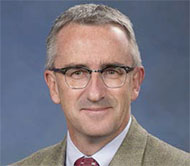
John Gordon
The European Journal of Inorganic Chemistry has chosen John Gordon (Inorganic, Isotope, and Actinide Chemistry, C-IIAC) to serve on its International Advisory Board. Gordon’s duties will include acting as an ambassador for the journal in the US and at conferences. The editor of the journal may also refer matters concerning authors in the US to him for his advice. The term of office will begin in January 2016 and continue for three years, and it can be extended.
The European Journal of Inorganic Chemistry was formed to consolidate the publications of the chemical societies of Spain, Belgium, France, Germany, Greece, Italy, the Netherlands, Portugal, Hungary, Austria, the Czech Republic, Poland, and Sweden into a highly selective source for important work in inorganic chemistry. The international journal receives over 50% of all papers from countries other than the members listed. Since its inception, the scope of the journal has expanded to cover all areas that are included in inorganic chemistry in the widest sense. Wiley-VCH publishes the journal.
Gordon joined the Laboratory almost 20 years ago. He has received the Los Alamos Fellows Prize for Leadership in Science, and has been appointed to the rank of Fellow of the American Association for the Advancement of Science (AAAS), the Royal Society of Chemistry, and Los Alamos National Laboratory. He has published approximately 100 peer-reviewed publications and holds 8 issued patents. Technical contact: John Gordon
Los Alamos Northern New Mexico IEEE Section wins two excellence awards

Photo. LANNM Section volunteers celebrate the Outstanding Small Section Award at a social gathering in Los Alamos on IEEE Day. (From left): Robert Owczarek (University of New Mexico), Bruce Carlsten (LANL), Gregg Giesler (COMPA Industries), Peter Clout (Vista Control Systems Inc.), Heather Quinn, David Izraelevitz, Christopher Brislawn, Hanna Makaruk, Zack Backer, Michael Ham, Randy Roberts, and Teri Roberts (all LANL).
The Los Alamos Northern New Mexico (LANNM) section of the Institute of Electrical and Electronics Engineers (IEEE) has received 2015 Outstanding Small IEEE Section awards for excellence in local activities. Volunteers from the Lab run most of the activities, including technical talks open to the public, professional development training, student events promoting science and engineering, and recruiting. After winning the award in the Southwest Area of Region 6, the section advanced to the Region 6 competition, where it won in competition with other small sections of less than 500 members. The IEEE consists of 10 regions worldwide, of which Region 6 in the US is the largest covering western states where high-tech companies abound.
LANL volunteers include Section Chair Hanna Makaruk (Applied Modern Physics, P-21), Section Vice-chair Bruce Carlsten (Accelerator and Operations Technology, AOT-DO), Signal Processing Society Chapter Chair David Izraelevitz (Space Data Systems, ISR-3), Computer Society Chapter Chair Michael Ham (P-21), Nuclear and Plasma Sciences Society Chapter Chair Nathan Moody (Accelerators and Electrodynamics, AOT-AE), Women in Science and Engineering Affinity Group Chair Heather Quinn (ISR-3), Young Professional Affinity Group Chair Charles Weaver (Space Electronics and Signal Processing, ISR-4), and Section Historian and former Chair Teri Roberts (Data and IT Quality Management, SAE-1). Tom Tierney (Intelligence & Systems Analysis, A-2), longtime volunteer and past section chair, serves with the IEEE-USA Board of Directors as Vice President for Government Relations.
IEEE professional interests cover practically all science and technology, including nuclear, photonic, power, software engineering, and biotechnology. IEEE serves as an umbrella organization for many specialty professional societies, the largest of which is the Computer Society. The LANNM Section includes some of these local chapters. Technical contact: Hanna Makaruk
Bioscience
Sequence and transcriptome analysis of microalga reveal potential applications
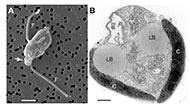
Figure 1. Chrysochromulina tobin cell structure. (A) Scanning electron micrograph of C. tobin. Two flagella are visible (marked F) along with the prominent coiled haptonema (white arrow). Scale bar represents 2.5 microns. (B) Electron micrograph of whole cell: Lipid body (LB); Mitochondrion (M); Chloroplast (C). Scale bar represents 500 nanometers.
A publication in PLOS Genetics describes how comprehensive genome sequence data from Los Alamos is helping scientists understand the algae strain Chrysochromulina tobin, and how it might be modified and used for biofuel production and other applications.
Microalgae are important contributors to global ecological balance and process nearly half of the world’s carbon each year. These organisms are deeply rooted in the Earths’ evolutionary history. Moreover, some algae strains have a natural ability to produce lipids in high concentration. To better understand why algae are such strong survivors in aquatic environments, their contribution to global ecology, and potential product applications, the research team sequenced the genome and transcriptome of C. tobin, a strain of algae in the class Haptophyceae. The microalga is abundant in both fresh and marine environments. Their high fatty acid content makes them a highly nutritive food source and a potential source of material for diesel fuel and many economically valuable co-products.
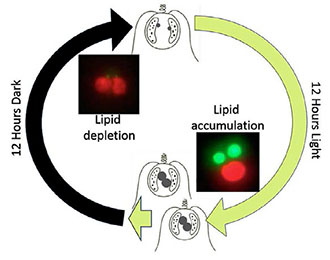
Figure 2. C. tobin displays photoperiod controlled cell division and lipid metabolism. Change in lipid body size correlates to photoperiod when detected by dye incorporation (green); chloroplast auto-fluorescence (red).
Los Alamos researchers collaborated with the University of Washington for the research. The team sequenced and analyzed the entire C. tobin genome and transcriptome data collected at seven time points over a 24-hour light/dark cycle to understand the pathways leading to high production of lipids and the conditions that can result in upregulation of the pathways. The team observed that a day-night cycle, similar to that found in natural environments, significantly impacts the expression of algal genes whose products are responsible for synthesizing fats. The transcriptome data gave insight into the timing of lipid production and which genes and promoters are used. The lipid bodies continuously increase in size during the light photoperiod, and then shrink rapidly during the dark cycle. In addition, cell division is the highest during the light to dark transition. The team’s findings provide insight into the means to genetically modify the microalga to increase lipid production.
The researchers made other discoveries with potential applications. They found new antimicrobial compounds and genes and described gene products that enhance the ability of the alga to use light energy. A new class of light sensitive proteins in the rhodopsin family may have an impact in the emerging field of optogenetics (a biological technique that uses light to control cells in living tissue). Genomic knowledge of haptophytes will enhance commercial endeavors that target aquaculture feed stocks, nutraceuticals, plastics or biofuel production. Because many haptophytes can produce toxins, genomic information will support research to understand the fundamental metabolic processes associated with the genesis of harmful algal bloom events.
Reference: “Genome Sequence and Transcriptome Analyses of Chrysochromulina tobin: Metabolic Tools for Enhanced Algal Fitness in the Prominent Order Prymnesiales (Haptophyceae).” PLOS Genetics; published online September 23, 2015; doi: 10.1371/journal.pgen.1005469. Authors: Blake T. Hovde (University of Washington – Seattle, currently a postdoc in Bioenergy and Biome Sciences, B-11), Chloe R. Deodato, Heather M. Hunsperger, Scott A Ryken, Will Yost, Jonathan Patterson, Raymond J. Monnat, and Rose Ann Cattolico (University of Washington-Seattle); Ramesh Jha (Biosecurity and Public Health, B-10); Steven B. Barlow (San Diego State University); and Shawn R. Starkenburg (B-11).
The Defense Threat Reduction Agency (DTRA), DOE National Alliance for Advanced Biofuels and Bioproducts (NAABB), and the Los Alamos Institutional Computing Resource sponsored different aspects of the Los Alamos work. The research supports the Lab’s Energy Security and Global Security mission areas and the Science of Signatures science pillar. Technical contact: Shawn Starkenburg and Ramesh Jha
Computer, Computational and Statistical Sciences
When two neutron stars merge
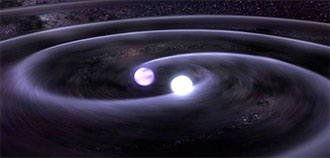
Figure 3. An artist’s conception of two neutron stars, moments before they collide. Credit: NASA Goddard
Scientists think that neutron star mergers produce short-duration gamma-ray bursts (GRBs). These GRBs are powerful explosions that can be seen from billions of light-years away. The mergers also may be the dominant source of detected gravitational waves and the dominant source of the heavy r-process elements in the universe. Christopher Fryer (Computational Physics and Methods, CCS-2) led a multidisciplinary study to better understand the fates of these mergers. The Astrophysical Journal published the work. The American Astronomical Society (AAS) highlighted the research in an article highlighting in the October 28, 2015 edition of AAS Nova.
Fryer and a team of experts from many areas of physics and astronomy, including dense nuclear matter, binary stellar evolution, gamma ray-bursts and multi-physics computational modeling conducted the research. They used a combination of Newtonian merger calculations, neutron star equation of state studies, and population synthesis simulation to model the outcome of the merger of the two neutron stars. The researchers determined the statistical likelihood that the remnant formed from the merger 1) collapses directly to a black hole, or 2) collapses to a black hole after a delay, or 3) remains a neutron star.
Whether or not the core is a black hole or neutron star depends on whether it is more massive than the maximum neutron star mass at its spin rate. This depends upon the still-uncertain equation of state describing the interior of a neutron star. If the maximum neutron star mass is below 2.3–2.4 solar masses, most neutron mergers will result in a black hole within 100 milliseconds of the merger. In that scenario, most mergers would be capable of producing gamma ray-bursts.
However, if the maximum neutron star mass is above this cutoff, then the majority of neutron star mergers will form a neutron star remnant – only rarely launching a gamma ray-burst. This would require a rate of mergers significantly higher than what the theory predicts. Based on the current understanding of binary and stellar evolution, the team concluded that nonrotating neutron star masses likely are limited to 2.3–2.4 solar masses. Planned observational projects like the advanced LIGO (Laser Interferometer Gravitational-Wave Observatory) should help to test this theory and place further constraints on the models of neutron stars.
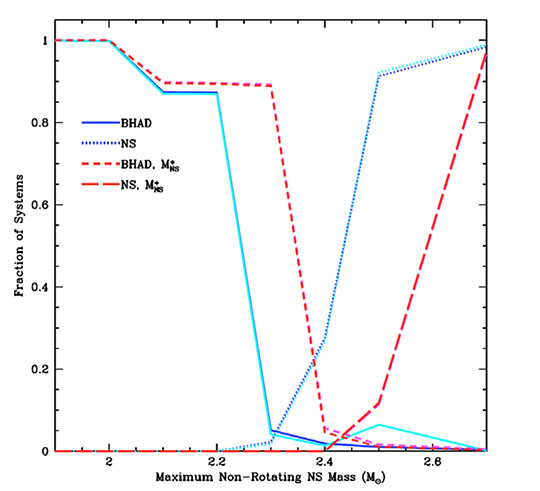
Figure 4. Fraction of systems that produce standard Black Hole Accretion Disk (BHAD) gamma ray bursts (GRBs) and neutron stars (ns) for the four basic population models: standard NS masses (BHAD—solid, NS—dotted) for old (blue) and new (cyan) initial orbital parameters, NS masses increased by 0.1 M (BHAD—dashed, NS—long-dashed) for old (red) and new (magenta) initial orbital conditions. The orbital conditions have virtually no effect on these results and the variation caused by other binary population synthesis parameters is also negligible. The primary error in these estimates is that of the initial mass distribution of neutron stars, producing an equivalent error in the maximum non-rotating NS mass limit on the equation of state.
Reference: “The Fate of the Compact Remnant in Neutron Star Mergers,” The Astrophysical Journal 812, 24, (2015); doi: 10.1088/0004-637X/812/1/24. Authors: Chris L. Fryer (Computational Physics and Methods, CCS-2 and University of Arizona – Tucson), Krzysztoff Belczynski (University of Warsaw), Enrico Ramirez-Ruiz (University of California – Santa Cruz), Stephan Rosswog (Stockholm University), Gang Shen (University of Washington – Seattle), and Andrew W. Steiner (University of Tennessee – Knoxville and Oak Ridge National Laboratory).
The NNSA Advanced Simulation and Computing (ASC) program and the DOE Office of Science, Office of Nuclear Physics funded the LANL work. The work supports the Lab’s Nuclear Deterrence mission area and the Nuclear and Particle Futures and Information, Science, and Technology science pillars. Technical contact: Christopher Fryer
Materials Physics and Applications
Experiments reveal possibility of polaronic Bose-Einstein condensates in UO2(+x)
A research team used ultrafast terahertz spectroscopy and microwave dissipation to identify potentially definitive evidence for a polaronic Bose-Einstein condensate (BEC) in photo- and chemically doped uranium oxide [UO2(+x)]. The evidence implies a state of matter with potential exotic properties. A macroscopic quantum object created by chemical doping (or equivalently, by photodoping through ultrafast laser excitation) persisting to ambient temperature and residing in a bulk solid would be revolutionary in a number of scientific and technological fields because the material could be controlled or “tuned” for specific functionalities. Scientific Reports published their findings.
Scientists discovered the Bose-Einstein condensate, a state of matter, in 1995, and included it with solid, liquid, gas, and plasma as the coldest and most sluggish of the group. In new work, a team made Bose-Einstein condensates with polarons, a type of quasiparticle, and observed concomitant high mass and temperature, up to 300 K. This result indicates a novel coherence mechanism.
That some of the signatures of coherence in an atom-based system extend to ambient temperature suggests a novel mechanism that could be a synchronized, dynamical, disproportionation excitation that promotes the coherence. Such a mechanism would demonstrate that the use of ultra-low temperatures to establish the Bose-Einstein condensate energy distribution is not a necessity and for the particles to be in the same state is attainable by other, perhaps less-challenging means.
The researchers performed ultrafast terahertz spectroscopy at the Laboratory for Ultrafast Materials and Optical Science at Los Alamos, part of the Center for Integrated Nanotechnologies (CINT), a DOE Office of Science user facility. Building on previous research on the chemically and photo-doped, partly filled 5f Mott insulator UO2(+x), the team performed optical pump-terahertz time domain spectroscopy to reveal the coherence that is a definingcharacteristic of a condensate. They also examined microwave absorption spectra that exhibited dissipation and some broad, complicated, highly temperature-dependent vortex-like features, but much lower radio frequency energies attributed to the lower stability of the condensate. The experimental evidence points to identifying the condensate as mesoscale bosons composed of phase coherent fermionic polarons formed from charge defects in the lattice. The surprising aspect of these quasiparticles is their persistence at ambient temperature despite the dynamical interplay of charge transfer between the condensate and the massive uranium lattice ions.
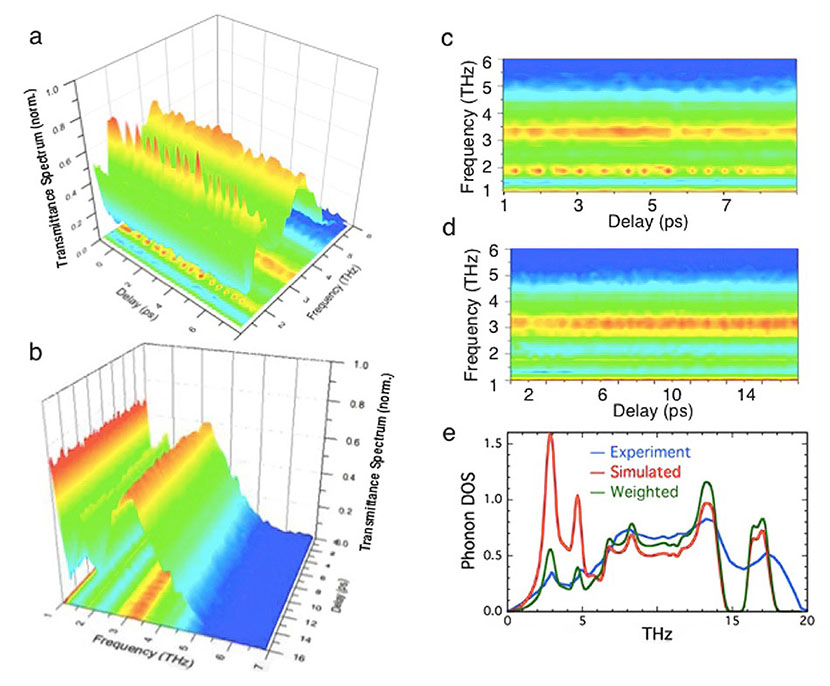
Figure 5. Time evolution of optical pump-terahertz time domain spectroscopy probe experiments. (a) Frequency of the normalized transmission as a function of time up to 8 ps following excitation at 1.57 eV. Regular modulation of the amplitude on top of the peak at 1.8 THz is apparent. (b) Frequency as a function of time following excitation at 3.14 eV, across the Mott gap, which does not show oscillations. (c/d) Overhead views of (a/b), with the colors representing the same amplitude of the normalized transmittance. (e) Calculated and experimental phonon density of states.
The work is an example of science that could benefit from a high time-resolution facility like MaRIE, the Laboratory’s proposed experimental facility for Matter-Radiation Interactions in Extremes. Researchers could use MaRIE’s x-rays to study polaronic-based Bose-Einstein condensate collective response with direct access to polaron lattice coupling information via x-ray scattering in a time resolved manner to yield complementary dynamics as done with terahertz spectroscopy.
Reference: “Possible Demonstration of a Polaronic Bose-Einstein(-Mott) Condensate in UO2(+x) by Ultrafast THz Spectroscopy and Microwave Dissipation,” Scientific Reports 5, 15278 (2015); doi: 10.1038/srep15278. Authors: Steven Gilbertson and George Rodriguez (Center for Integrated Nanotechnologies, MPA-CINT), Tomasz Durakiewicz (Condensed Matter and Magnet Science, MPA-CMMS), Alan Bishop (Science, Technology and Engineering, PADSTE), David Andersson, Darrin Byler, and James Valdez (Materials Science in Radiation and Dynamics Extremes, MST-8); lead author Steve Conradson (formerly of MST-8, now at Synchrotron Soleil in France); and collaborators from the University of Rochester and Uppsala University. J. D. Thompson (MPA-CMMS) performed magnetic susceptibility measurements.
The Laboratory Directed Research and Development (LDRD) program and the DOE Office Science, Basic Energy Sciences, Materials Sciences and Engineering and the Chemical Sciences, Biosciences, and Geosciences Divisions funded different aspects of the Los Alamos work. The research supports the Laboratory’s Energy Security mission area and the Materials for the Future science pillar by demonstrating pathways to controlled functionality and providing understanding of actinide oxide fuels. Technical contact: George RodriguezMaterials Science and Technology
Origins of radiation tolerance in complex materials
Knowing what makes some complex materials radiation tolerant is important for improving nuclear fuels and nuclear waste storage. A report in the journal Nature Communications provides new insight into the matter, generalizing the previous understanding and providing a new path for developing radiation-tolerant materials for use in extreme environments.
The research aims to understand at a fundamental level: 1) how materials respond to being irradiated, and 2) how that response depends on fundamental properties of the material, such as its crystal structure and crystal chemistry. The researchers examined oxide ceramics that have potential application for storing nuclear waste and the development of advanced nuclear fuels. The investigators discovered that fundamental differences in the structure of the material play a key role in how those materials respond to irradiation.
The relative ease in swapping cations is key to radiation tolerance. Using a combination of experimental characterization and a variety of simulation techniques, the Los Alamos researchers determined that different types of complex oxides have a fundamentally different response to irradiation. Decades of work on one class of complex oxides, pyrochlore (A2B2O7), have revealed that there are correlations between the ability of the cations (A and B) to swap position and the radiation tolerance of the material. Pyrochlores in which A and B can easily be swapped (such as when A=Er and B=Zr) are radiation tolerant.
In contrast, for pyrochlores in which this swapping is difficult (A=Er and B=Ti), the material quickly amorphizes under irradiation. This transformation from a crystalline to an amorphous structure is inherently bad for performance because it is accompanied by changes in volume and the ability of other species to leach from the material.However, different oxides produced different results. The researchers examined another class of complex oxides, spinels (AB2O4), to determine if the same relationship holds. They irradiated three different chemistries of spinels and examined how the spinels responded to the irradiation damage. The team found the opposite behavior from what was observed in pyrochlores: if the A and B cations are hard to swap in spinels, the material is more, not less, radiation tolerant. The investigators used atomistic simulation methods to examine these results. They attribute this difference to the fundamental manner in which the A and B atoms are arranged. There are holes in the cation structure in spinels that facilitate rearrangement back to the ordered structure. These holes do not exist in pyrochlore. Once the cations swap in pyrochlore, they are stuck there. Due to the holes, spinels can rearrange easily to recover the original structure. Thus, the fundamental difference is related to the holes – cation structural vacancies – that exist in one material but not the other.
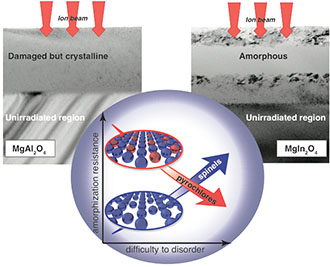
Figure 6. Schematic highlights the relationship between the energetics of disordering and amorphization resistance as a function of the cation structure of the derivative compound, spinel or pyrochlore. In spinels that have cation vacancies relative to the basic rocksalt structure, amorphization resistance is proportional to the difficulty to disorder the compound. The kinetics of reordering, facilitated by the cation vacancies, is faster as the disordered phase becomes less favorable. These kinetics are absent in fluorite-derivative compounds that have the same cation density as the basic fluorite structure. Energy builds up faster in compounds that have higher energies to disorder. These compounds are thus less resistant to amorphization.
The new insight from combined experimental and modeling effort generalizes the understanding that had been developed from the study of pyrochlores and provides new opportunities for identifying radiation-tolerant oxides for nuclear applications.
Reference: “Opposite Correlations between Cation Disordering and Amorphization Resistance in Spinels versus Pyrochlores,” Nature Communications 6, 8750 (2015); doi:10.1038/ncomms9750. Authors: Blas Uberuaga, Ming Tang, James Valdez, and Yongqiang Wang (Materials Science in Radiation and Dynamics Extremes, MST-8); and collaborators with Thermo-Calc Software Inc., Loughborough University, and the University of Tennessee.
The DOE Office of Science (Basic Energy Sciences, Materials Sciences and Engineering Division) funded this work, which supports the Laboratory’s Energy Security mission area and Materials for the Future science pillar. Researchers performed ion irradiations at the Ion Beam Materials Laboratory at Los Alamos, a DOE user resource supported by the DOE Office of Basic Energy Sciences and Office of Nuclear Energy, Laboratory Directed Research and Development (LDRD), and University of California lab-fee research. Technical contact: Blas UberuagaMesoscale Materials Science on the Roadmap to MaRIE
Key development for implementing the next generation of high brightness x-ray sources
Researchers have successfully designed, fabricated, and tested a new x-ray lens made from diamond. The material enables phase-preserving diamond optics. This is a promising advance in the development of the high-quality optics needed for MaRIE (Matter-Radiation Interactions in Extremes), the Laboratory’s proposed facility for time-dependent materials science at the mesoscale, and other high-energy x-ray light sources,
MaRIE would provide a bright source of high-energy x-ray photons. Focusing elements concentrate the x-rays on the region of interest are required to enable the full potential of the source to be realized. Beryllium is one of the best lens materials available for x-ray optical properties, and a large fraction of the existing refractive x-ray lenses in use around the world are made from beryllium. Unfortunately, beryllium has drawbacks. It is usually produced as polycrystalline material, cannot handle high heat loads, and is hazardous. The polycrystallinity degrades the photon phase profile that is produced by the source, and the poorer thermal quality of beryllium precludes its routine use as the first optical element facing the source.
Diamond has long been realized as an excellent material for x-ray lenses due to its good optical properties for x-ray photons. More importantly, diamond has an order of magnitude higher thermal conductivity and lower thermal expansion compared with beryllium, and its excellent hardness would enable its use in the high heat-load present at new high brightness sources like the planned MaRIE.
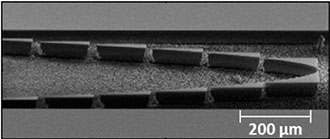
Photo. A prototype kinoform x-ray optic formed in single-crystal diamond by deep reactive ion etching.
Diamond solves most of the problems of beryllium, but it is difficult to fabricate the precise shapes needed to make high quality x-ray lenses. This new research has successfully fabricated the complex shapes in diamond required for x-ray lenses. The photo shows a visible light image of a diamond kinoform lens, etched into a diamond chip of size 4.5-mm x 4.5-mm and 0.5-mm thick. This shape focuses in one direction and produces a line focus. The Center for Functional Nanomaterials at Brookhaven National Laboratory performed the design and fabrication with electron beam lithography. Modern Microsystems conducted reactive ion etching. Researchers tested the lenses at the CHX beamline at NSLS2 at Brookhaven.
The top panel of Figure 9 is an image of the 280-μm x 55-μm rectangle of light that was incident on the diamond lens shown in the photo. The bottom panel reveals the one-dimensional focusing effect of the lens, collecting the light into an 8-μm x 55-μm line.
Participants include: Richard Sheffield (Experimental Physical Sciences, ADEPS), Kenneth Evans-Lutterodt, Andrei Fluerasu, A. Stein, and Lutz Wiegart (Brookhaven National Laboratory); and Craig McGray (Modern Microsystems).
MaRIE-related capability development (Cris Barnes, Capture Manager) funded the Los Alamos research, which supports the Laboratory’s Nuclear Deterrence mission area and Materials for the Future and Science of Signatures science pillars. Technical contact: Richard Sheffield
Physics
TRIDENT experiments measure imprint of rippled shocks in solid metal
Shock front perturbations undergo damped oscillations as they propagate. The frequency of the perturbations depends on shock velocity, perturbation wavelength, and the shear response of the medium (e.g., fluid viscosity). The study of the dependence of shock front oscillation frequency on flow stress is important because many instances of impact-driven phenomena result in perturbed shocks. This can change the shock behavior through the material relative to the planar shock case. Researchers performed experiments on LANL’s TRIDENT laser to study how finite shear strength or flow stress alters the oscillation frequency of the shock front in metals and to validate phase-aware strength models, which are required to describe high-pressure response of polymorphic materials.
Transient imaging displacement interferometry (TIDI) is an optical technique that measures shock front amplitude modulations to better than one-tenth of the probe laser wavelength. The investigators employed TIDI to measure the imprint of modulated shock waves out to 35 ns after shock breakout (arrival of the shock front at the opposite target surface) at initially smooth surfaces in copper and iron. Scientists use the measured shock imprint and surface growth data to compare with hydrodynamic simulations of the experiment using the Preston-Tonks-Wallace strength model.
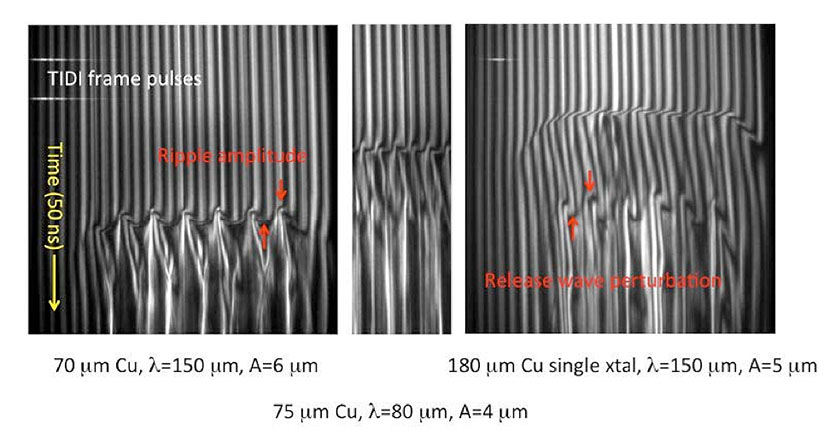
Figure 7. Line VISAR traces of rippled shock and release waves on copper targets.
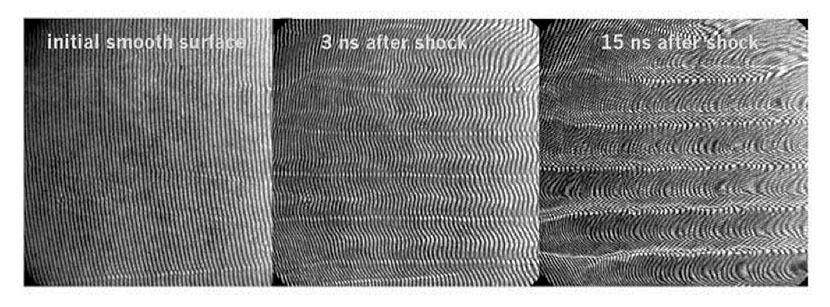
Figure 8. Rippled shock imprint of 1 micron amplitude in a copper target.
Figure 8 depicts the evolution of a copper surface following arrival of a 150-micron wavelength shock front perturbation. The researchers conclude that the large surface growth that TDI observed at 15 ns corresponds to the arrival of the release wave perturbation
Researchers include: Eric Loomis, Randy Johnson, and Tom Shimada (Plasma Physics, P-24); Pedro Peralta and Jenna Lynch (Arizona State University).
The Department of Energy Office of Fusion Energy Sciences funded the work, which supports the Laboratory’s Nuclear Deterrence and Energy Security mission areas and Science of Signatures science pillar. Technical contact: Eric Loomis





